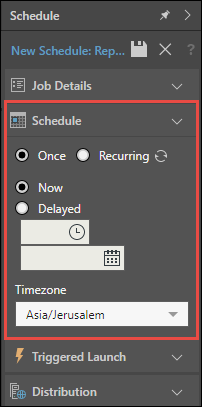When you’re ready to schedule your publication, select Schedule from the Home ribbon. You can then configure your scheduling and distribution preferences from the Schedule panel. Scheduling can also be set from the content explorer interface. The content explorer also provides an interface for managing your schedules and viewing rendered output.
Note: Administrators can view all schedules in the system from the administrative console.
Important: this feature is not available in the Community Edition.
Job Details
Name your publication schedule, add a description, and select the required format under Output. Available output types are: PDF, Word, Excel, PowerPoint, Html, Json, and Xml.

Selections
Selections will be displayed if you’ve added slicers to your publication. This is where you can configure the behavior of the slicers within the publication. Select either Basic or Multiple:
Basic
Allows you to select a single slice option (element) for each slicer added to the publication. The report will be filtered according to the chosen element(s).

Multiple
Allows you to select multiple slicer elements from each slicer, and then produces multiple copies of the publication, with each copy filtered by a different slicer element.
Select Multiple, and then click the plus sign to display your Publication slicer(s). For each slicer, open the drop down menu and select the slicer type:
- All Items: all slices in the slicer.
- First Item: filters by the first slice in the slicer.
- Last Item: filters by the last slice in the slicer.
- Custom: enables custom selection of a slice. To select multiple (but not all) slices, click the plus sign to add another slicer selection.

Schedule
Determine exactly when your schedule will be run.
Once
Schedule your publication to run once only, either immediately, or at a specified time and date.
- Now: the schedule will run immediately
- Delayed: the schedule will run at the specified time and date
Recurring
Schedule your publication to be run on a recurring basis.
- Run Now: check this box to run the schedule immediately.
- Hourly: run the job every x hours, starting from the specified time and date.
- Daily: run the job on the given Specific Days, or every x days (Days Interval).
- Weekly: run the job every x weeks, on the specified days.
- Monthly: run the job on the given quarters or months. Then select:
- Week and Days: to run the schedule during the specified week of the given month(s), and on a given day.
- Calendar Days: to run the schedule on a given calendar day, or the last day of the month.
- Workdays: to run the schedule on a specific workday during the month, or on the Last Workday of the Month.
- On Days: to run the schedule on a specific workday of the month. For example, enter 12 to have the schedule run on the 12th workday of the month.
Time and Date Settings
- For each recurring schedule option, you must select a start date and time - this is when the schedule job will start running.
- You can select an optional end date and time, when the schedule job will stop running. If no end date and time are given, the schedule will continue running indefinitely.
- Select the required timezone from the Timezone drop-down list.

Triggered Launch
Schedule your publication to run only if a certain condition or a series of conditions are met. Triggers are driven off query results. For details about configuring a triggered launch, click here.

Distribution
Determine how your publication will be delivered to recipients. To learn about distribution options, click here.
Data Source Authentication
If the data source used in the discovery or presentation is based on Windows Authentication, then a separate panel will be presented to the user. The user may need to supply a set of credentials to successfully submit the scheduled task.
This often occurs when the authentication method for the data source is set to "End-user" Windows Authentication. Under this model, the user running the queries is used to connect (via Kerberos token) to the data source. However, when running a batch task (offline), the user's token is not available - as such a set of their credentials is required for connectivity by the Pyramid engine.
This may not be required if the website authentication is via Basic or Forms.
Schedules can also be configured for SAP BW sources if SAP Logon Tickets is selected as the authentication method in the Admin console. In this case, you'll be prompted to enter the relevant credentials.
Note:SAP Logon Tickets are available with an Enterprise license only.